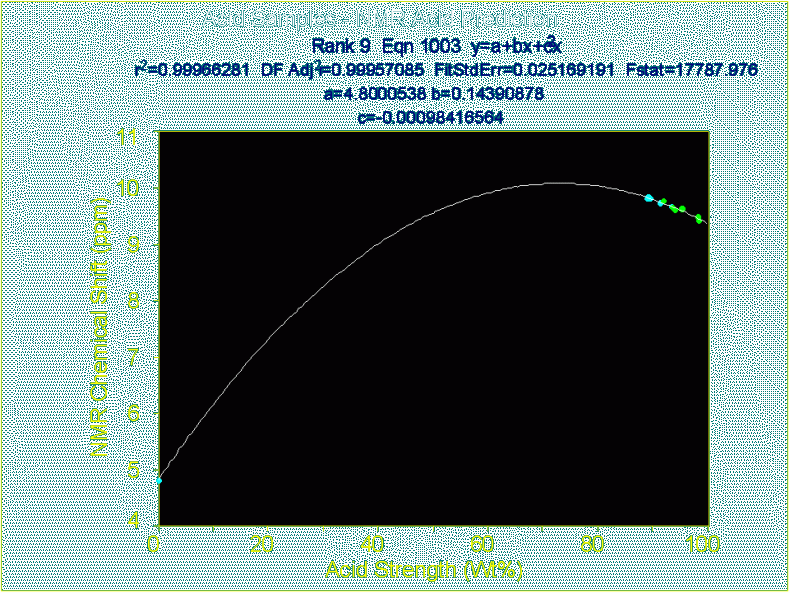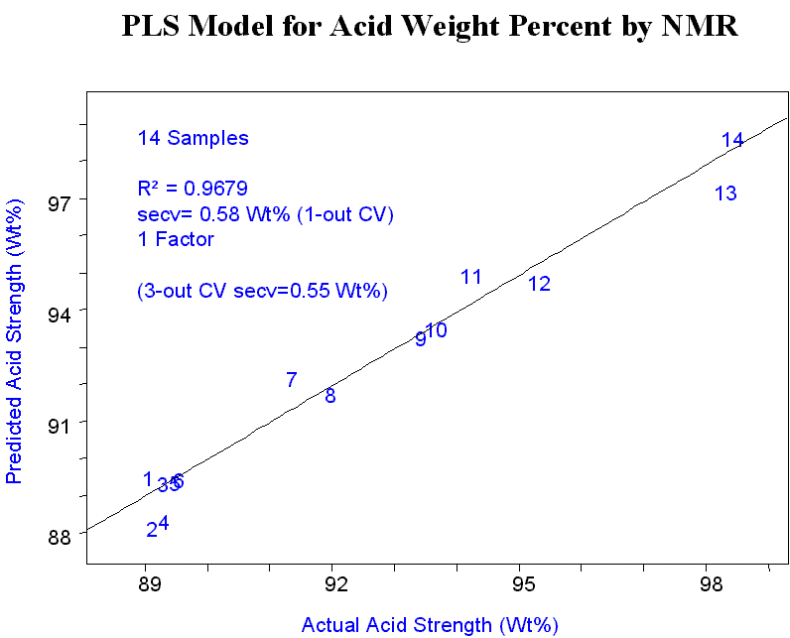NMR Application – Sulfuric Acid Alkylation
The alkylation unit control system provides composition measurement and control solutions to reduce or eliminate problems characteristic of sulfuric acid alkylation unit operation. The system applies NMR technology for stream composition analyses with tightly integrated advanced process control to deliver optimum unit performance.
The NMR Process Systems analyzer uses a non-invasive technique to measure acid strength, acid/hydrocarbon emulsion quality, hydrocarbon-to-olefin ratio, and acid soluble oil content of the emulsion stream in the reaction zone of the alkylation process.
By using a process line slipstream directly from the reaction zone to the instrument, the analyzer avoids limitations of other measurement technologies. An NMR system does not require direct contact with the acid/hydrocarbon stream and, therefore, does not have to handle the usual problems of corrosion, wear, contamination, and consequent response deterioration commonly found with other types of analyzers.
Another advantage of using an NMR system is that it does not require breaking the emulsion to make a measurement. The analysis is obtained directly from the sample – without altering the sample in any way – and is then returned to the main process stream.
Achieving the following objectives maximizes alkylation unit profitability:
- Maximize alkylate make
- Maximize isobutane/olefin ratio
- Maximize the use of low cost feed in preference to higher cost feed when alternative fresh feedstocks are available
- Maximize propane recovery
- Minimize isobutane losses in product streams
The benefit contributed by the NMR analyzer alone can amount to 10% to 15% of acid costs.
NMR Application Details
Approach 1: NMR Sampling Intact Emulsion in Contactor
On-line Acid Strength Measurement and Sulfuric Acid Alkylation Process Control Using Process NMR
John C. Edwards and Paul J. Giammatteo,
Presented at ISA, April 1998, Research Triangle Park, NC
Abstract
On-line nuclear magnetic resonance (NMR) technology measures acid strength, acid/hydrocarbon emulsion quality, hydrocarbon to olefin ratios, and acid soluble oil content on the intact emulsion stream in the reaction zone of the alkylation process. By using a process line slip-stream from the reaction zone, non-invasive NMR analysis overcomes most of the limitations of other analyzer technologies. With no direct analyzer contact with the acid stream in the NMR, corrosion, response deterioration, wear, and/or contamination problems experienced by other acid strength measurement technologies do not interfere with NMR analyses. Longer on-stream analysis times, high accuracy, rapid measurement capabilities, and low instrument maintenance, make process NMR unique in acid alkylation control.
Since the measurement is done at the reaction zone, NMR measures the intact acid/hydrocarbon emulsion, typically in well under two minutes. Acid strength determination by NMR does not require any emulsion breaking, and, along with acid strength, the same NMR analysis measures the emulsion quality, feed ratios, and acid soluble oil content. Utilizing these parameters, true process optimization and improved margins can be obtained through:
- reduced acid consumption
- expanded utilization of hydrocarbon feed types and distributions (C3-C5)
- improved alkylate quality
- ability to regulate acid feed rates with changing feed compositions
- ability to operate alkylation units at or near design limits
Introduction
In April 1997, the first on-line process NMR analyzer for sulfuric acid alkylation control was installed at a Los Angeles area refinery. The justification for installation was based on high acid costs at that particular plant. Currently the acid strength setpoint for the alkylation process is 90.5 wt% H2SO4. The ability to control acid strength in the third of three Stratco contactors (in series) to 88.0-89.0 wt% H2SO4 translates into a $1 million dollar per year savings in acid costs. In addition to the reduction of acid costs it is hoped that close control of the unit by NMR will lead to improved operating efficiencies and improved product quality. These operating efficiencies include: i) the ability to expand the utilization of hydrocarbon feed types and distributions (C3-C5), ii) the ability to regulate acid feed rates with changing feed compositions, and iii) the ability to operate the unit at or near design limits. Safety improvements are also obtained by reducing the need for manually grabbed acid samples for titration.
NMR is particularly well suited to analysis of the acid/hydrocarbon emulsion in the reaction zone because it is a rapid, non-invasive technique that observes the hydrogen chemistry of the intact emulsion. All other analysis methods currently being applied to alkylation acid are performed in the settler or in the lab (titration) where the acid/hydrocarbon emulsion has been broken. The NMR analyzer observes the emulsion directly by monitoring the reaction zone, a measurement that cannot be performed by any other analyzer. The Los Angeles NMR analyzer has been on-line continuously since its installation, proving its ruggedness and reliability.
Discussion
Figure 1 shows the placement of the NMR analyzer on a slip-stream taken from the main line between the Stratco contactor and the settler. The 3/8″ slip-stream simply flows through the NMR probe where it is irradiated with RF frequency and the NMR signal obtained.
Figure 2 shows the actual NMR spectrum of an intact sulfuric acid emulsion stream. Data collection and processing times are well under two minutes. The peak that is observed at 10.9 ppm is due to the acid/water component of the emulsion. This peak represents the rapidly exchanging protons of H2O and H2SO4 . The peaks in the 0-5 ppm region are due to the various hydrocarbons in the emulsion. Acid weight percent (<±0.75 wt%) is determined by measuring the varying peak position of the acid peak relative to the fixed peak positions of the hydrocarbon protons. The acid peak position varies as a function of the acid strength in the emulsion. The measured acid peak position is placed into a third order regression equation relating that peak position to the acid strength (<±0.75 wt%).
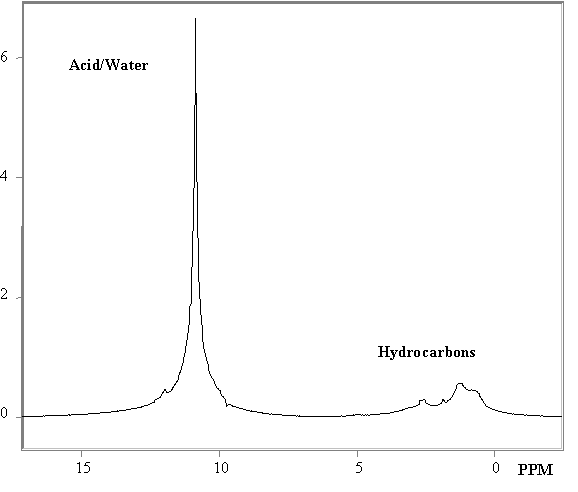
Figure 2: On-Line 1H NMR spectrum of the intact H2SO4/hydrocarbon emulsion.
Figure 3 shows the hydrocarbon area of the spectrum and the associated assignments of the various proton types that are observed.
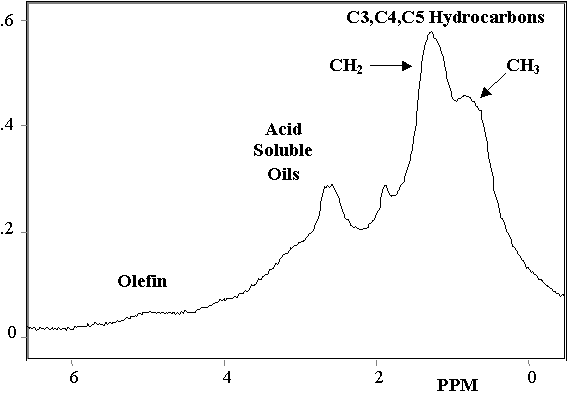
Figure 3: 1H NMR spectrum of the hydrocarbon region of the intact emulsion.
Peak integration curves are shown in Figures 2 and 3. Each integration area corresponds to the amount of acid, olefin, acid soluble oil, and hydrocarbons in the intact process stream that are observed by the NMR. These integration regions are used to obtain the following process parameters as follows:
- acid to hydrocarbon integration ratio is used to evaluate the quality of the emulsion
- hydrocarbon to olefin integration ratio is used to monitor feed ratios
- acid soluble oil content is monitored with the ASO integration
One NMR measurement taking less than two minutes yields four process parameters critical in optimizing and expanding alkylation unit performance.
Figure 4 shows the comparison of the on-line NMR acid measurement versus lab titration analyses. Lab samples were taken every four hours and required full separation of the acid/hydrocarbon emulsion before acid titrations could be performed. NMR data was obtained at approximately the same time that the lab samples were drawn from the alky unit. However, the NMR continuously monitored the acid strength as well as the other process parameters listed above once every fifteen minutes. NMR acid strength accuracy is comparable to lab measurement to within ±0.5 wt%.
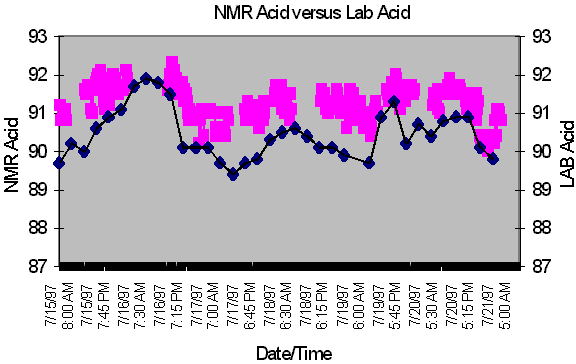
Figure 4: Comparison of laboratory titration acid strength measurements with acid strength calculated from the 1H process NMR spectrum of the intact emulsion.
Conclusion
The first successful demonstration of process NMR utilized to control an acid alkylation unit at a Los Angeles area refinery has been performed. The analyzer has been on-line continuously since April 1997 and has been providing accurate (<±0.5 wt%) acid weight percent numbers since July 1997. There has been no NMR related failure of the analyzer. The only down time has been due to a power outage and one air conditioner failure on the enclosure. The analyzer outputs are currently in the DCS of the refinery and operator training is now under way.
Approach 2: NMR Sampling Spent Acid in Settler
Slide 1
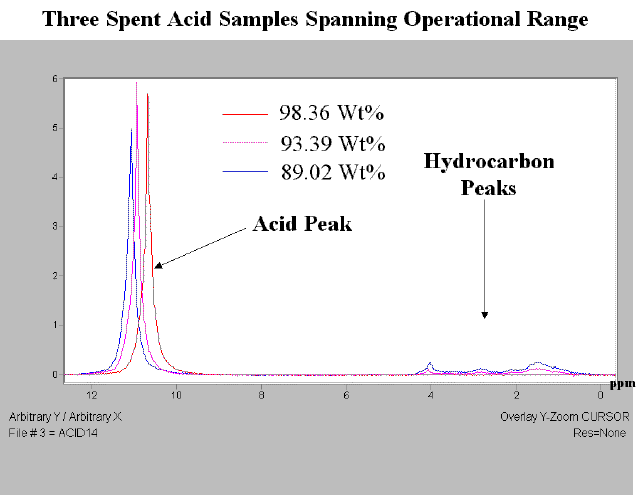
Slide 2
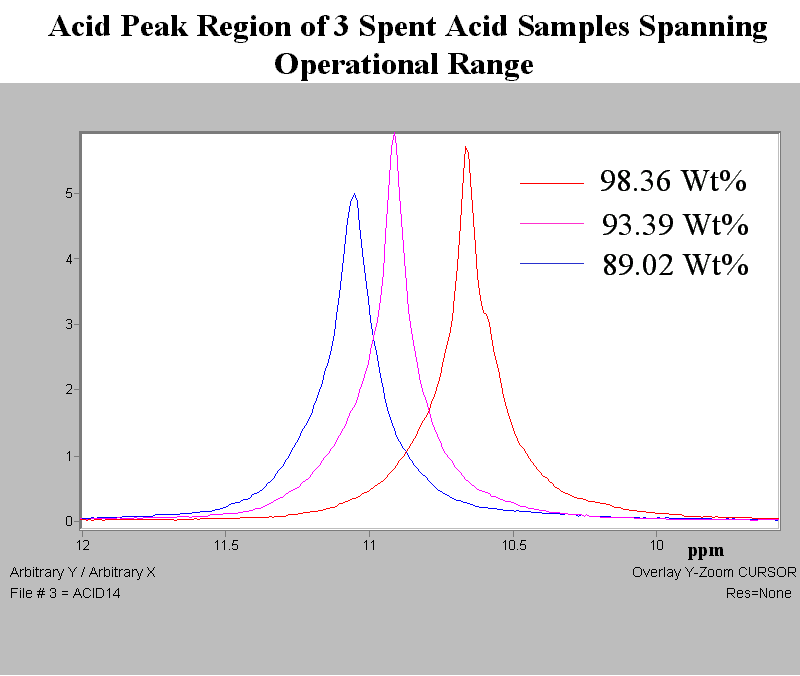
Slide 3
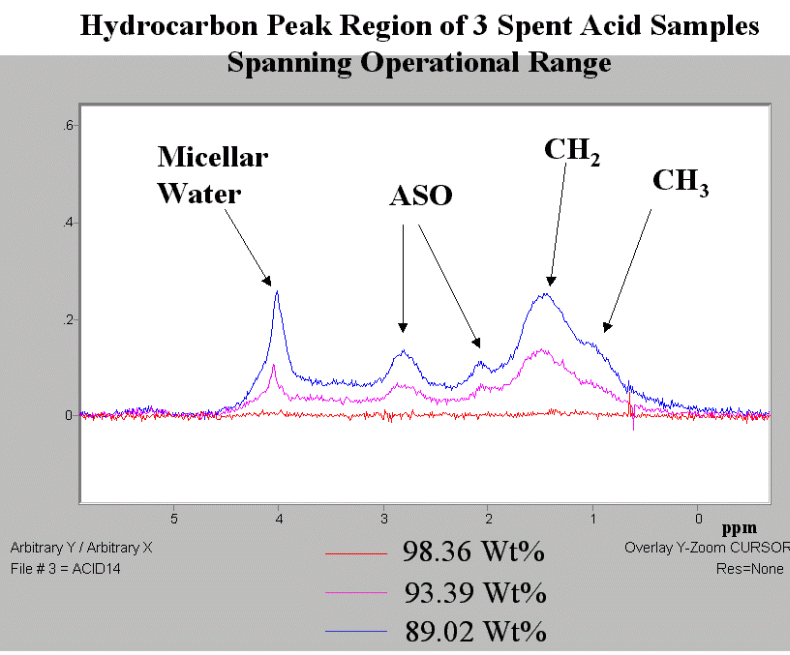
Slide 4
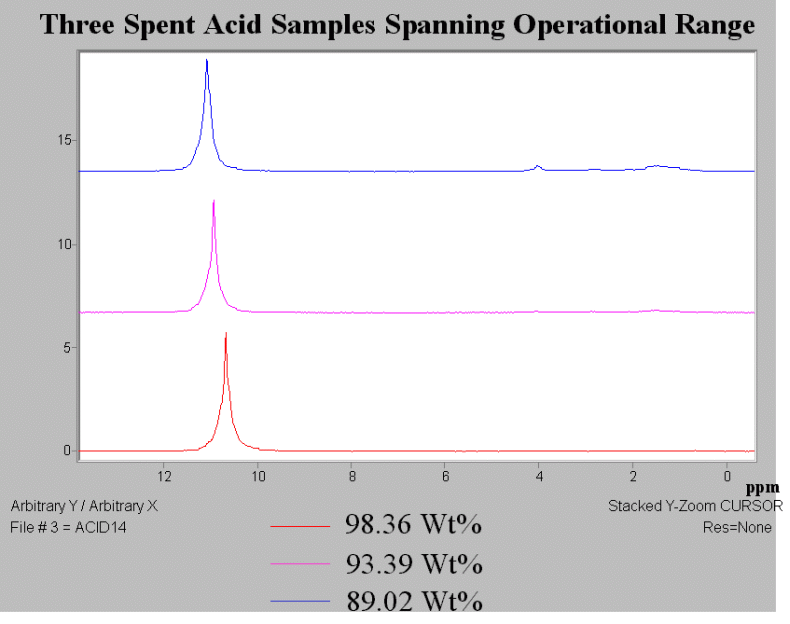
Slide 5
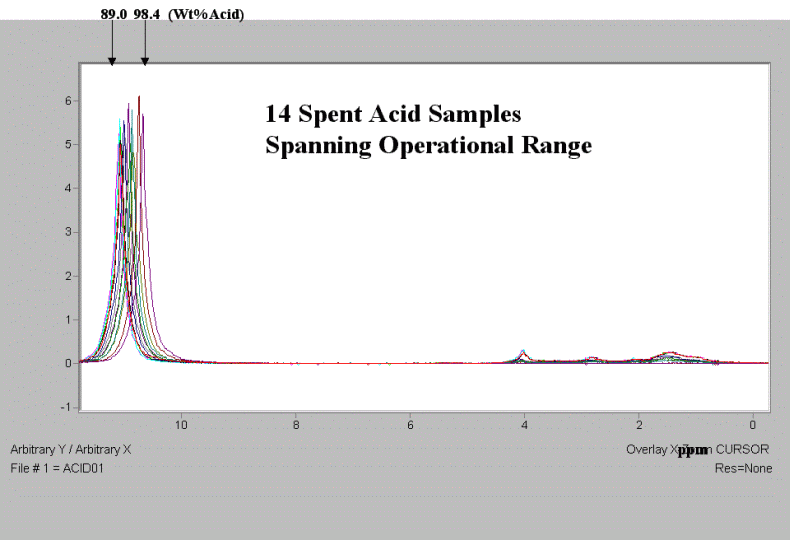
Slide 6
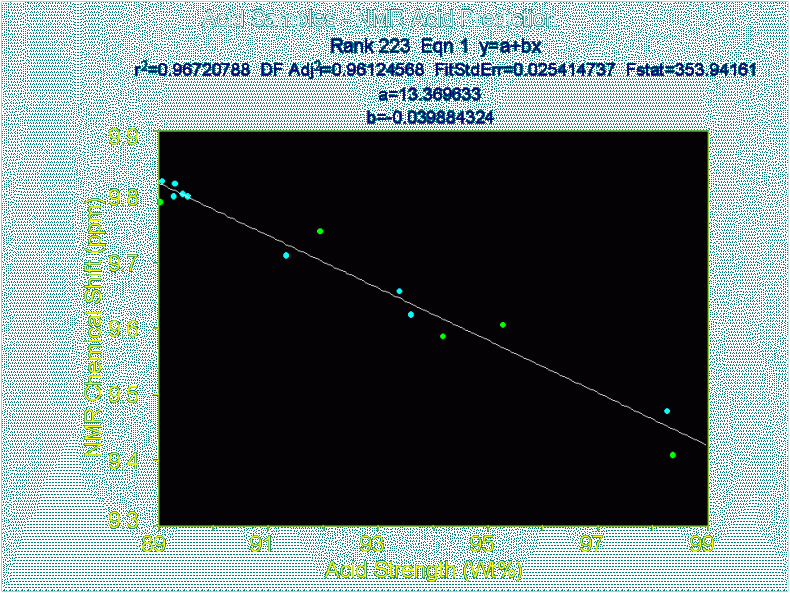
Slide 7
